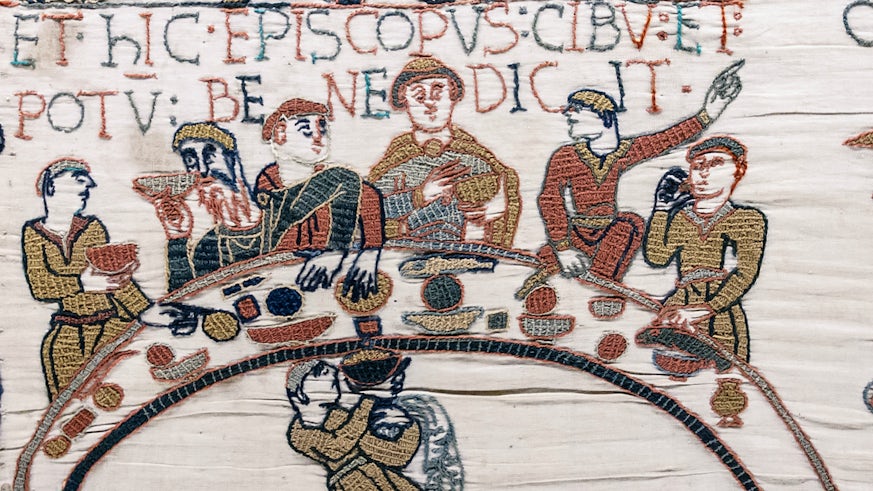Food culture after 1066
10 October 2016

950 years after William of Normandy landed on English soil in one of Britain’s landmark historic moments, Cardiff University researchers are aiming to discover what impact the invasion had on diet, cooking habits and health.
The Dietary Impact of the Norman Conquest will examine human and animal remains and pottery from pre- and post-Conquest Oxford to tell the story of the impact of 14 October 1066, better known as the Battle of Hastings.
Specialists from the Universities of Sheffield and Bristol are collaborating on the research project funded by Cardiff University, the Society of Antiquaries of London, the Royal Archaeological Institute and the Society for Medieval Archaeology.
Profound socio-political change in England is clear following the Norman Conquest. Sensitive to socio-political changes, diet can indicate cultural preference, economics and identity. Previous archaeological and historical research has shown that elite taste changed quickly with the arrival of French cuisine. More pork, chicken and venison was consumed, but the impact on the wider population remains unclear.
This new study aims to reveal:
- how the diet of ordinary people changed
- how cooking habits altered
- the wider impact of the Norman Conquest on the physical health of a specific population
Specialists in medieval artefacts, Saxo-Norman archaeology, funerary archaeology and bioarchaeology will use a multi-scalar approach to investigate one city in depth, focusing on Oxford as a cultural cross-roads between north and south in the early medieval period.
The project is unique in the suite of multi-scalar methods it brings together:
Stable isotope analysis of bone collagen to reveal diets at an individual level
Analysis of bone chemistry will provide direct evidence for the diets of the Oxford population at an individual level. This approach will assess the contribution of meat, fish and grain in the diet. The research includes bulk analysis of bone providing a long-term average of diet and multiple incremental analyses of teeth to provide much tighter snapshots of food sources and also health during childhood and adolescence. Through the Cardiff University Research Opportunities Placement scheme, Archaeology undergraduate students Will Barrow and Rachael Mott have been given a unique opportunity to collaborate in this research.
Human osteology to show the impact of dietary changes
Palaeopathological assessment of the skeletal and dental health of individuals from Oxford cemeteries, undertaken by Dr Elizabeth Craig-Atkins and MSc student Allie Taylor from the University of Sheffield will examine the physiological impact of dietary changes.
Organic residue analysis of ceramics to indicate how and what was being cooked
Samples of pottery from recently excavated sites in Oxford will establish the foods processed in vessels (e.g. pork, lamb, beef, dairy, fish) before and after the invasion. This will be achieved through lipid residue analysis undertaken by Dr Lucy Cramp (University of Bristol).
Leading the project Dr Ben Jervis, expert in Saxo-Norman archaeology at Cardiff University’s School of History, Archaeology and Religion said: “This study provides a unique glimpse into the impact of 1066 on domestic activities."

"Through a focus on food culture, our research will build a deeper understanding of the implications of early medieval socio-political change for the everyday lives of ordinary people.”
Bioarchaeologist Dr Richard Madgwick, also of the School of History, Archaeology and Religion, adds: “The novel suite of methods we’re employing will provide unparalleled resolution on the diet and health of the pre- and post-Conquest communities in Oxford."

"The real value of the results will be in the detail – not only providing an overarching picture of diet and health across the community, but also in specific individuals and even precise phases in individuals’ lives. This is genuinely unique in a medieval context."
The real value of the results will be in the detail – not only providing an overarching picture of diet and health across the community, but also in specific individuals and even precise phases in individuals’ lives. This is genuinely unique in a medieval context.’
Dr Elizabeth Craig-Atkins, Lecturer in Human Osteology at the University of Sheffield, said: “Analysis of the human skeleton can provide a range of valuable information about health and dietary change, but data from archaeological human remains have never been effectively integrated into studies exploring the impact of the Conquest. We have been able to generate a large sample of data concerning metabolic diseases, dental disease and general biological stress which will, for the first time, be fully integrated with both isotope and ceramic evidence to examine how ordinary people’s lives really changed after the Norman Conquest.”
Completing in early 2017, The Dietary Impact of the Norman Conquest will share findings directly with the people of Oxford at Oxfordshire Museum and in academic journals to further advance research on this monumental transition in British History.
Share this story
The School allows the brightest and best to explore and share their passion for past societies and religious beliefs, from prehistory to the present day.


